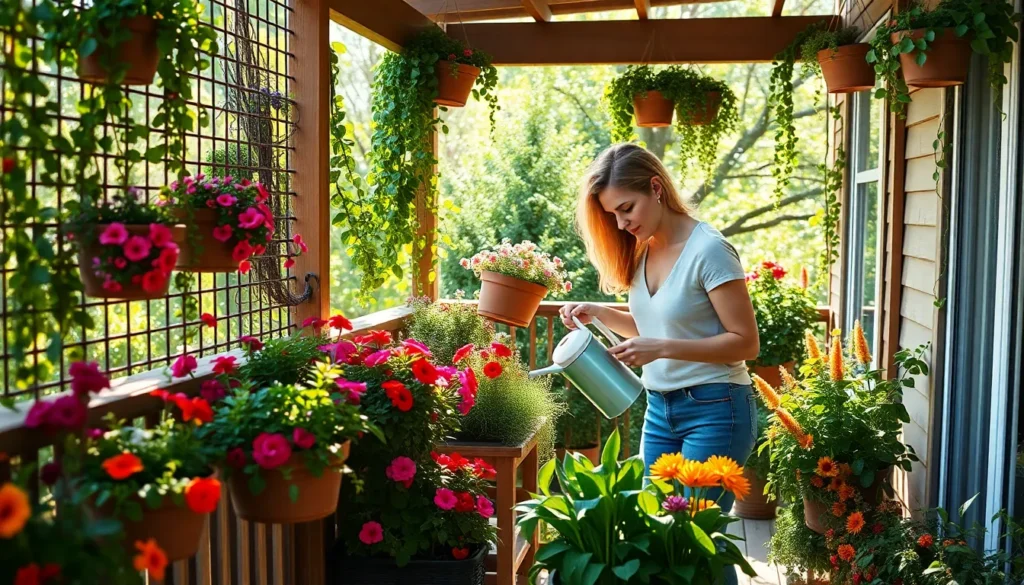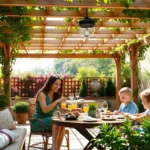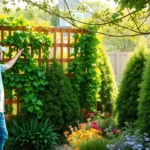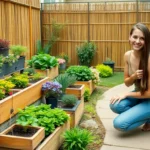We’ve all dreamed of having a lush garden but felt limited by our outdoor space. That’s where deck gardening comes in – transforming your deck into a vibrant oasis that’s both beautiful and functional. Whether you’re working with a sprawling deck or a cozy balcony there’s a garden design that’ll work perfectly for your space.
Deck gardens offer incredible versatility and year-round enjoyment. You can grow everything from fresh herbs and vegetables to stunning flowers and ornamental plants without the backbreaking work of traditional ground gardening. Plus you’ll have better control over soil quality drainage and plant placement.
We’re about to share game-changing deck garden ideas that’ll turn your outdoor space into the envy of your neighborhood. From vertical growing systems to container combinations that create maximum impact these proven strategies will help you design a deck garden that thrives in any season while boosting your home’s curb appeal.
Create a Vertical Garden Wall for Maximum Space Efficiency
Maximizing your deck’s growing potential becomes achievable when you build upward instead of outward. Vertical garden walls transform limited deck spaces into productive growing areas that can yield 3-4 times more plants than traditional horizontal arrangements.
Choose the Right Vertical Planters
Modular pocket planters offer the most flexibility for deck garden walls because they’re lightweight and customizable. These fabric or plastic systems typically hold 6-12 plants per square foot and can support herbs like basil, lettuce, and small flowering plants. Wall-mounted planter boxes work best for heavier plants such as tomatoes or peppers since they provide deeper root space and better structural support.
Living wall systems create stunning focal points while maximizing plant density on your deck. Companies like Woolly Pocket and VertiGarden manufacture systems that can accommodate 20-30 plants in a 4×4 foot area. Trellis planters combine climbing support with container growing, making them perfect for vining crops like cucumbers or morning glories.
Recycled materials can become effective vertical planters with proper drainage modifications. Wooden pallets, old gutters, and plastic bottles create budget-friendly options that still deliver excellent growing results for herbs and small vegetables.
Select Climbing and Trailing Plants
Edible climbing plants maximize your deck garden’s productivity while creating natural privacy screens. Sugar snap peas, pole beans, and cucumber varieties can produce 2-3 pounds of food per plant when grown vertically. Cherry tomatoes like ‘Sweet 100’ or ‘Surefire Red’ thrive in vertical systems and can yield 4-6 pounds per plant throughout the growing season.
Flowering vines add color and attract beneficial pollinators to your deck space. Morning glories, nasturtiums, and sweet peas create beautiful displays while requiring minimal horizontal space. These plants typically reach 6-10 feet in height and bloom continuously from spring through fall.
Trailing plants work perfectly in upper levels of vertical walls where they can cascade downward. Strawberry varieties like ‘Albion’ or ‘Seascape’ produce fruit while creating attractive green waterfalls. Cherry tomatoes, trailing petunias, and ivy geraniums add visual interest when planted in elevated positions.
Install Proper Irrigation Systems
Drip irrigation systems ensure consistent watering throughout your vertical garden wall without waste. Self-watering vertical planters with built-in reservoirs can maintain proper soil moisture for 3-5 days between refills. These systems typically cost $50-150 and reduce daily maintenance significantly.
Gravity-fed watering works effectively for smaller vertical installations using elevated water containers. A 5-gallon bucket with drip tubing can irrigate 15-20 plants for several days. Soaker hoses threaded through vertical planters provide even water distribution while using 40% less water than traditional sprinklers.
Smart irrigation controllers connect to weather stations and soil moisture sensors to optimize watering schedules automatically. Systems like Rachio or Rain Bird can reduce water usage by 30-50% while maintaining healthier plants through precise moisture control.
Design Container Gardens with Strategic Plant Placement
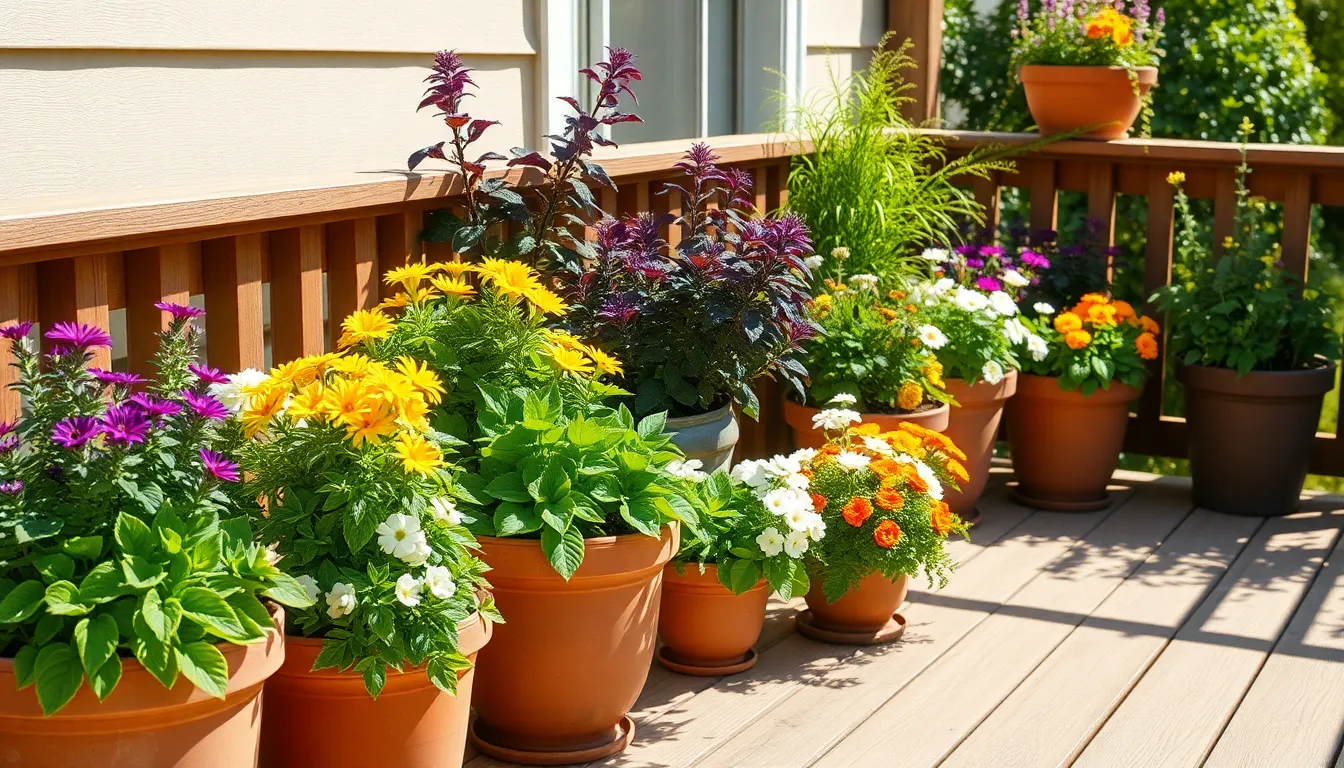
Strategic plant placement transforms ordinary container arrangements into stunning deck gardens that maximize both space and visual impact. We’ll show you how thoughtful positioning creates layers of beauty while ensuring each plant thrives in its ideal environment.
Group Plants by Height and Growth Patterns
Organizing plants by height creates natural layers that add depth and dimension to our deck gardens. We position tall plants like ornamental grasses or small shrubs in the back of containers, placing medium-height flowering plants in the middle section. Short ground cover plants and trailing varieties fill the front edges, creating a cascading effect that draws the eye downward.
Growth patterns matter just as much as height when we’re grouping our container plants. Spreading plants need adequate space to expand without crowding their neighbors, while upright growers can be planted closer together. We cluster plants with similar water and sunlight needs, making maintenance easier while ensuring optimal growth conditions for each variety.
Mix Textures and Colors for Visual Appeal
Combining different leaf textures creates visual interest that goes beyond simple color combinations. We pair broad-leafed plants like hostas with fine-textured ornamental grasses, adding spiky plants such as lavender or rosemary for contrast. These textural combinations catch light differently throughout the day, creating ever-changing shadows and highlights that enhance our deck’s aesthetic appeal.
Color mixing follows the same principle of contrast and harmony that professional designers use. We combine complementary colors like purple and yellow blooms, or we create monochromatic schemes using different shades of the same color family. Foliage colors matter too – we integrate silver-leafed plants with dark green varieties to create stunning contrasts that remain attractive even when flowers aren’t blooming.
Consider Seasonal Rotation Options
Seasonal plant rotation keeps our deck gardens vibrant throughout the year while maximizing our container investments. We plan spring displays with cool-weather plants like pansies and primroses, transitioning to heat-loving annuals such as petunias and marigolds for summer months. Fall rotations feature chrysanthemums and ornamental kale, while winter containers showcase evergreen plants and colorful berry-producing shrubs.
Planning seasonal color schemes ensures our deck never looks bare or monotonous. We choose plants that bloom at different times, creating succession plantings that maintain colorful displays from early spring through late fall. This rotation strategy allows us to experiment with new plant varieties each season while keeping our deck garden fresh and exciting for both residents and visitors.
Build Raised Planter Boxes Along Deck Perimeters

Building raised planter boxes along your deck’s edges creates defined garden boundaries while maximizing growing space. These permanent installations offer structured planting areas that seamlessly blend your deck with surrounding industry elements.
Determine Optimal Box Dimensions
Proportion your planter boxes to match your deck’s scale to maintain visual harmony in your outdoor space. We recommend measuring your deck’s total square footage first, then allocating 15-20% of that space for planter boxes to avoid overwhelming the area.
Standard planter box dimensions work best when they’re 18-24 inches wide and 12-18 inches deep for most plants. Deeper boxes accommodate root vegetables and larger perennials, while shallower ones suit herbs and annual flowers perfectly.
Leave adequate walkway space of at least 36 inches between planter boxes and seating areas for comfortable movement. Corner installations require 24-30 inches of clearance to prevent the space from feeling cramped or difficult to navigate.
Select Weather Resistant Materials
Cedar lumber offers natural weather resistance and beautiful aging characteristics that complement most deck designs. This material contains natural oils that repel insects and resist moisture damage for 10-15 years without treatment.
Pressure treated wood provides affordable durability for budget conscious gardeners who want long lasting planter boxes. Choose lumber rated for ground contact to ensure maximum protection against moisture and soil contact.
Composite materials deliver low maintenance answers that won’t warp, crack, or require annual staining like traditional wood options. These materials typically cost 2-3 times more initially but eliminate ongoing maintenance expenses over their 20+ year lifespan.
Plan for Proper Drainage
Install industry fabric at the bottom of each planter box to prevent soil loss while allowing water to drain freely. This barrier keeps weeds from growing up through drainage holes while maintaining proper water flow.
Add a 2-3 inch gravel layer beneath your soil to create effective drainage and prevent waterlogging that causes root rot. Coarse gravel or crushed stone works better than fine materials that can compact and block water movement.
Drill drainage holes every 6-8 inches along the bottom of your planter boxes, making them 1/2 inch in diameter for optimal water flow. Position these holes slightly above the absolute bottom to maintain some moisture while preventing standing water accumulation.
Install Hanging Gardens from Deck Railings and Overheads

We can transform our deck’s vertical space into a stunning garden sanctuary by utilizing railings and overhead structures. This approach maximizes growing potential while creating beautiful natural focal points that enhance our outdoor living area.
Choose Appropriate Hanging Hardware
Heavy-duty hanging hooks provide the foundation for secure garden installations on deck railings and overhead beams. We should select weather-resistant materials like stainless steel or powder-coated brackets that can withstand outdoor conditions year-round. Professional consultation becomes essential when we’re uncertain about structural capacity or proper installation techniques.
Weight capacity ratings must exceed our total planter load by at least 25% to ensure safety margins. Attachment methods vary depending on our deck’s construction, with through-bolts offering the strongest connection for heavier installations. We’ll want to distribute mounting points across multiple support structures rather than concentrating weight in single locations.
Select Lightweight Container Options
Plastic and fiberglass containers offer the perfect balance of durability and weight reduction for hanging deck gardens. These materials resist cracking in temperature fluctuations while keeping our overall installation weight manageable. Woven baskets provide natural aesthetics but require liner installation to prevent soil spillage.
Size considerations should prioritize function over appearance when selecting hanging containers. We need planters that fit comfortably within our railing spacing without obstructing walkways or creating visual barriers. Container depths of 8-12 inches work well for most herbs and flowering plants, while trailing varieties need slightly deeper options.
Balance Weight Distribution
Weight calculations must account for saturated soil conditions since wet earth weighs significantly more than dry potting mix. We should estimate approximately 75-100 pounds per cubic foot of soil when fully watered to determine our structural requirements. Even distribution across multiple hanging points prevents stress concentration on individual support elements.
Placement strategies should create visual harmony while maintaining structural integrity throughout our hanging garden system. We can achieve optimal balance by alternating heavier planters with lighter arrangements along our deck perimeter. Strategic positioning also allows us to create natural privacy screens while keeping weight loads within safe parameters for our deck’s design specifications.
Incorporate Multi-Level Gardening with Tiered Planters
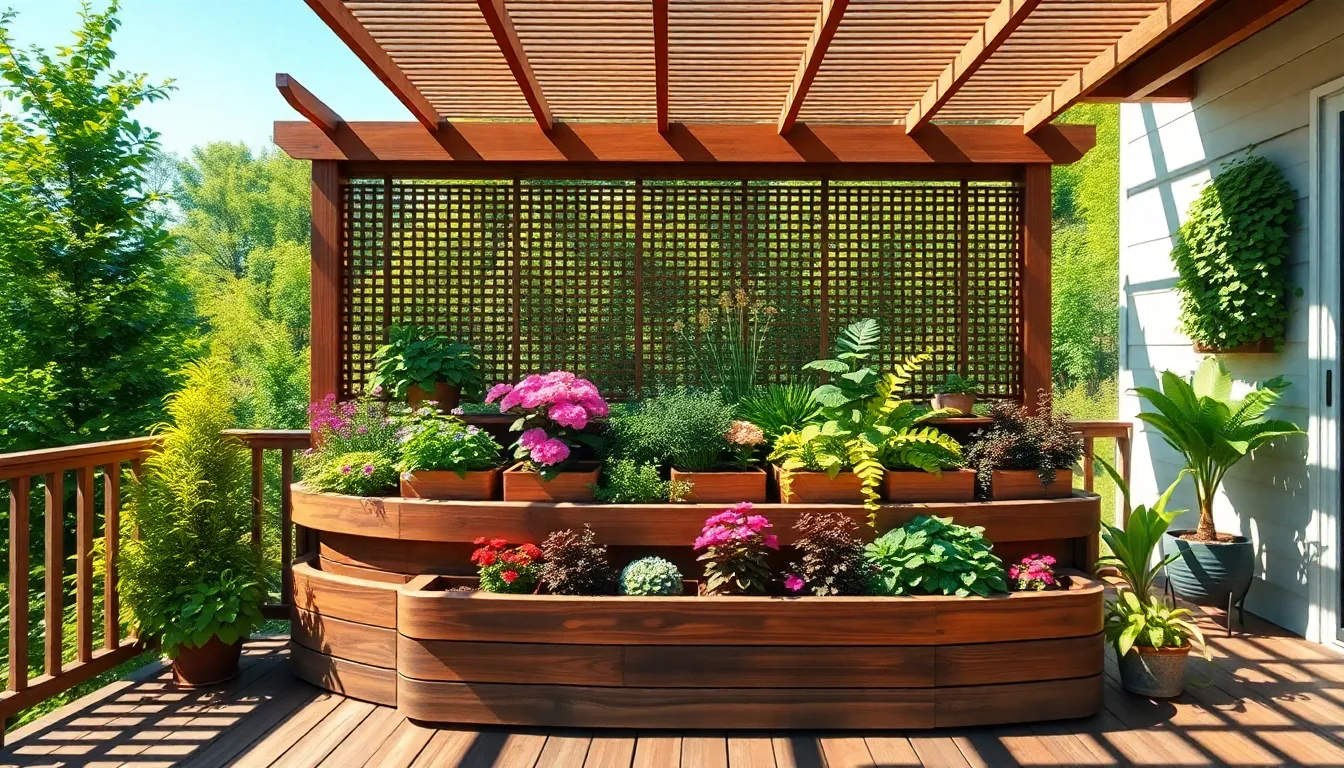
Multi-level deck gardens transform flat spaces into ever-changing growing environments that maximize both productivity and visual appeal. We can create sophisticated garden designs by implementing tiered planter systems that work at different elevations.
Create Visual Depth with Varying Heights
Visual depth emerges naturally when we arrange planters at different elevations throughout our deck space. Tiered planters of varying heights create a layered effect that draws the eye upward and makes small spaces appear larger than their actual footprint.
Louvered pergolas and trellises add structural height while providing support for climbing plants at elevated levels. These vertical elements create natural boundaries between different garden zones and establish clear sight lines throughout the space.
Layered layouts enhance visual appeal by positioning taller planters toward the back and shorter containers in front. This arrangement ensures every plant remains visible while creating natural depth that makes the garden feel more spacious and professionally designed.
Strategic placement of planters at different deck levels maximizes the three-dimensional potential of multi-level structures. We can integrate planters directly into deck railings, steps, and platform transitions to create seamless garden flow between elevation changes.
Maximize Growing Space in Small Areas
Vertical gardening techniques transform limited deck space into productive growing areas by building upward rather than outward. Wall-mounted planters and trellises make the most of vertical surfaces while keeping valuable floor space available for seating and movement.
Tiered planter systems allow us to grow significantly more plants in the same footprint compared to single-level arrangements. These systems can accommodate diverse plant types by creating microclimates at different heights and orientations.
Plant placement optimization ensures each species receives ideal growing conditions within the tiered system. We can position sun-loving plants on upper tiers while shade-tolerant varieties thrive in lower levels that receive filtered light.
Space efficiency increases dramatically when we combine different planter styles within the same area. Mixing hanging baskets with standing planters and wall-mounted systems creates maximum growing capacity without overwhelming the deck’s functionality.
Ensure Each Level Receives Adequate Light
Light analysis becomes crucial when designing multi-level garden systems that feature varying heights and orientations. We must assess sunlight exposure at each tier to determine optimal plant placement based on exact light requirements throughout different seasons.
Solar-powered lights and LED grow lights supplement natural illumination in shaded areas or during periods of limited sunlight. These artificial lighting answers ensure consistent growth conditions across all planter levels regardless of natural light variations.
Upper tier positioning typically receives the most direct sunlight, making these areas ideal for sun-loving vegetables and flowering plants. Lower levels often provide perfect conditions for shade-tolerant herbs and leafy greens that prefer filtered light conditions.
Light distribution planning helps us create balanced growing environments where each plant species thrives in its preferred conditions. We can rotate planters seasonally to optimize light exposure as sun angles change throughout the year.
Add Mobile Garden Carts for Flexibility
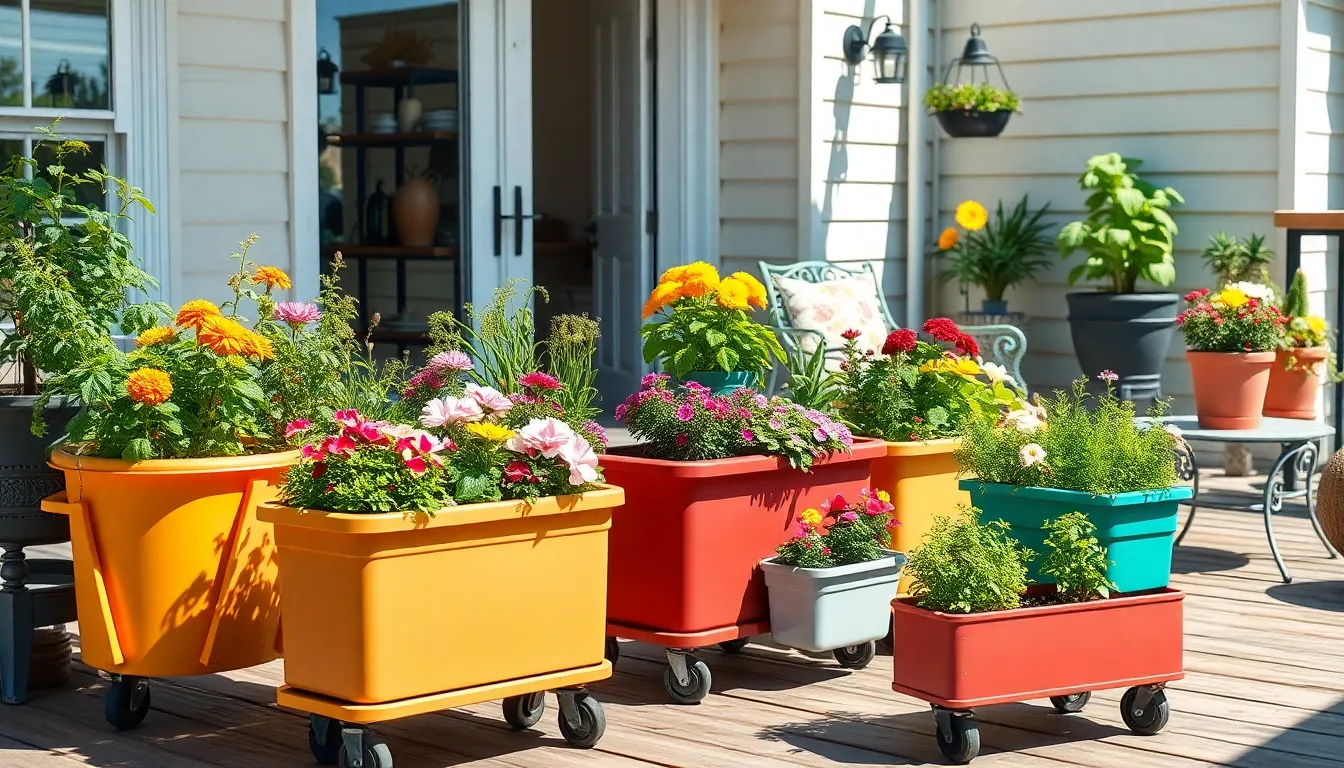
Mobile garden carts transform deck gardening by providing unmatched versatility and convenience. We can easily rearrange our entire garden layout to optimize growing conditions or accommodate different activities.
Select Rolling Planters for Easy Movement
Rolling planters offer the ultimate solution for deck gardens that need frequent repositioning. We recommend choosing planters with heavy-duty wheels that can support both the container weight and full soil load while rolling smoothly across deck surfaces.
High-quality caster wheels make the biggest difference in functionality. Industrial-grade casters with locking mechanisms prevent unwanted movement while allowing effortless repositioning when needed. We suggest selecting wheels with at least 4-inch diameter for easier rolling over deck board gaps.
Weight distribution becomes crucial when selecting rolling planters. Wide-base designs distribute weight more evenly across deck surfaces, reducing stress on individual deck boards. Rectangular planters typically offer better stability than round options when mounted on wheels.
Material considerations affect both durability and mobility. Lightweight materials like high-density polyethylene or fiberglass reduce overall weight while maintaining strength. Metal planters provide durability but increase the total weight we need to move around our deck space.
Create Seasonal Display Options
Seasonal rotation capabilities make mobile garden carts invaluable for year-round deck appeal. We can quickly transform our deck’s appearance by moving different plant collections into prominent positions based on seasonal themes.
Spring configurations feature fresh herbs and early flowering plants positioned in sunny locations. Mobile carts allow us to highlight emerging growth while protecting tender plants from unexpected cold snaps by moving them to sheltered areas.
Summer arrangements showcase heat-loving vegetables and vibrant annuals. We can rotate these displays to follow optimal sun patterns throughout the day, ensuring maximum productivity from our edible plants and longest blooming periods for flowers.
Fall transitions become effortless with mobile planters holding autumn foliage and late-season crops. We simply roll out summer displays to less visible areas while bringing forward containers filled with colorful mums, ornamental cabbages, and winter squash.
Winter focal points maintain deck interest during dormant months. Mobile evergreen displays, winter berry arrangements, and cold-hardy plants can be positioned prominently while less attractive dormant containers move to background locations.
Optimize Sun Exposure Throughout the Day
Strategic positioning maximizes each plant’s growing potential by following natural light patterns. We can move sun-loving plants to capture morning light on the east side, then relocate them to afternoon positions for extended exposure.
Shadow tracking helps us understand our deck’s light patterns throughout different seasons. Mobile planters let us respond to these changing conditions by repositioning plants as shadows shift with the sun’s angle.
Reflective surface placement works better with mobile systems. We can position planters near reflective surfaces like light-colored walls or windows during low-light periods, then move them away when direct sunlight becomes available.
Microclimate optimization becomes possible when we can relocate plants quickly. Hot summer afternoons might require moving sensitive plants to shadier locations, while cool spring mornings benefit from positioning plants in warm, sunny spots.
Seasonal sun angle adjustments are essential for year-round success. Winter’s lower sun angle means we need to position planters differently than summer arrangements, and mobile systems make these transitions seamless and efficient.
Integrate Herb Gardens for Functional Beauty
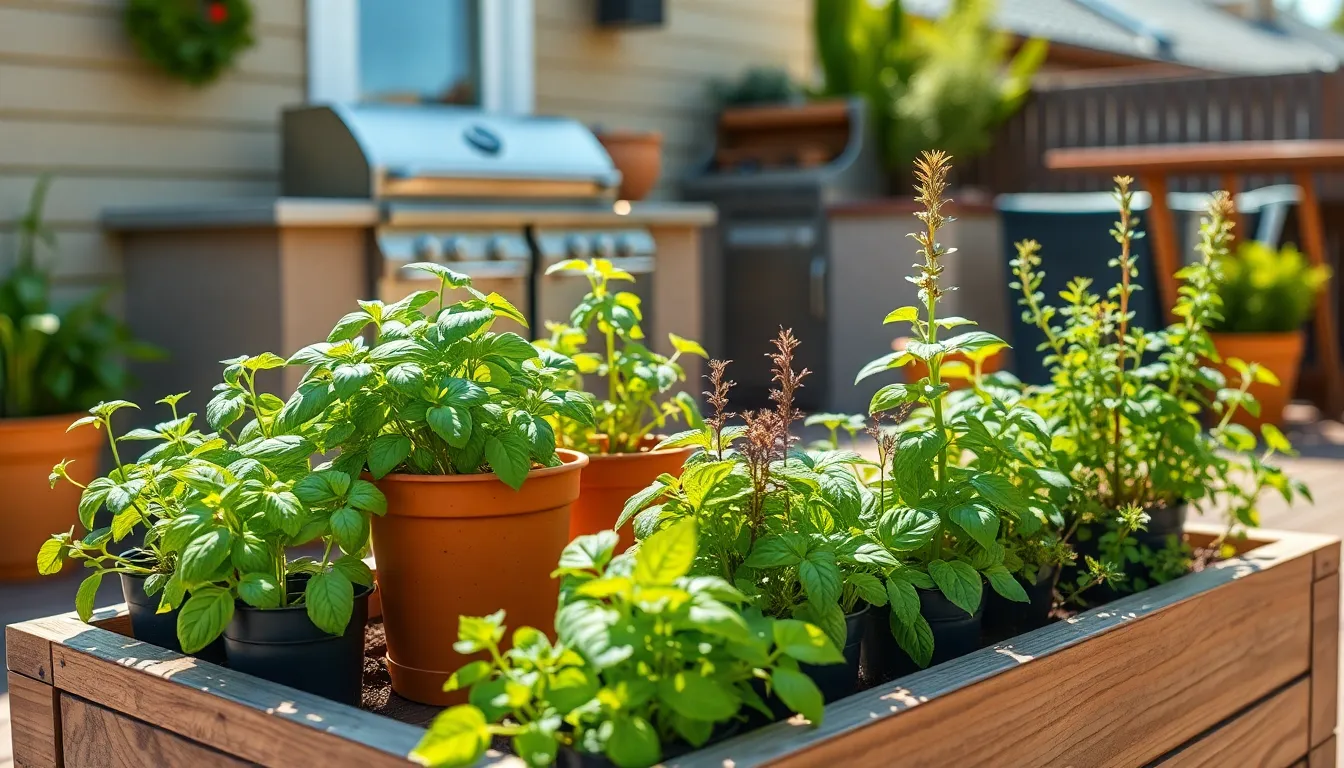
We can combine practicality with aesthetics by incorporating herb gardens into our deck design. These functional gardens provide fresh cooking ingredients while adding natural beauty and delightful fragrances to our outdoor space.
Position Herbs Near Kitchen Access
Positioning herb gardens close to the kitchen creates maximum convenience for daily cooking needs. This strategic placement allows us to quickly harvest fresh basil, thyme, or rosemary without interrupting our meal preparation. We’ll save time and reduce trips back and forth when our herbs are just steps away from the cooking area.
Accessibility becomes even more important during busy cooking sessions. Placing herb containers on deck sections that connect directly to kitchen doors or windows makes harvesting effortless. We can simply reach out and gather what we need without leaving the kitchen entirely.
Choose Compact Herb Varieties
Compact herb varieties maximize our growing potential in limited deck spaces. Dwarf basil, miniature rosemary, and small chive varieties thrive in containers while requiring significantly less room than their full sized counterparts. These space efficient options produce abundant harvests without overwhelming our deck garden design.
Container friendly herbs adapt well to deck growing conditions. Compact thyme varieties spread beautifully in shallow planters, while dwarf oregano provides intense flavor in small spaces. We can grow more herb types when we select varieties specifically bred for container cultivation.
Design for Easy Harvesting
Designing herb gardens at comfortable heights reduces strain during regular harvesting. Raised planters positioned at waist level or elevated containers make gathering herbs simple and enjoyable. We’ll encourage more frequent use when our herbs are easily accessible without bending or stretching.
Proper drainage systems ensure healthy herb growth throughout the growing season. Installing planters with adequate drainage holes and quality potting mix prevents waterlogged roots that can kill herb plants. We should also consider drip trays to protect deck surfaces while maintaining proper moisture levels.
Strategic arrangement of herb containers creates an efficient harvesting workflow. Grouping frequently used herbs like basil and chives in front positions while placing occasional use herbs like rosemary toward the back optimizes our garden layout. This organization system makes cooking preparation faster and more intuitive.
Design Privacy Screens Using Tall Plants and Trellises
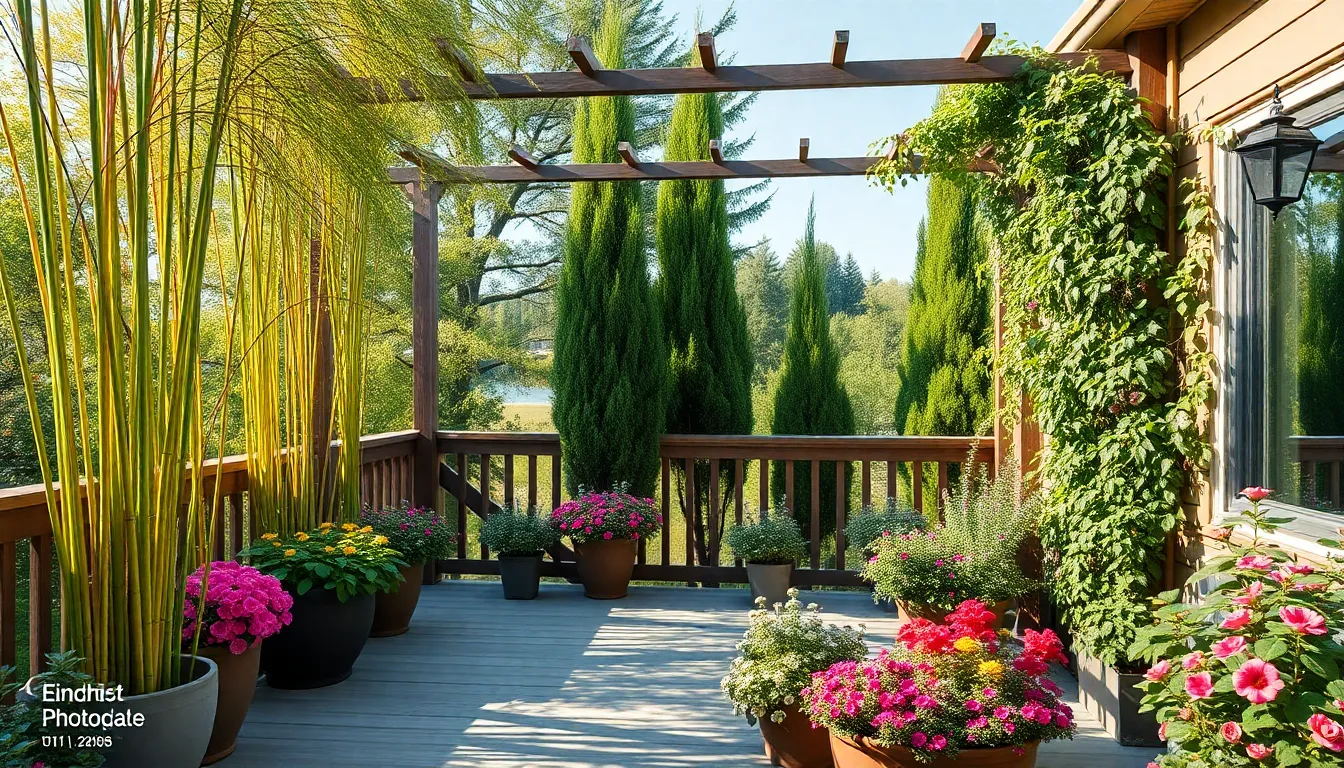
Creating effective privacy screens transforms your deck garden into a secluded retreat while maintaining aesthetic appeal. We’ll explore strategic approaches that combine natural barriers with functional structures to achieve optimal privacy without sacrificing airflow or visual interest.
Select Fast-Growing Screening Plants
Bamboo varieties offer the fastest growing solution for natural privacy screens, with some species reaching full height within 2-3 growing seasons. This versatile plant creates dense coverage while allowing air circulation through its natural structure.
Cypress trees provide another excellent fast growing option, with annual growth rates of 2-4 feet when properly maintained. These evergreen specimens can be pruned to maintain desired heights between 6-12 feet, making them perfect for deck scale privacy needs.
Arborvitae selections create dense barriers that grow 1-2 feet annually and respond well to container cultivation. We recommend choosing compact varieties like ‘Emerald Green’ or ‘Techny’ that maintain their shape without excessive pruning.
Boxwood plantings offer year round screening with moderate growth rates of 6-12 inches per season. These plants work exceptionally well in large planters arranged in rows to form continuous privacy barriers.
Install Sturdy Support Structures
Posts and rails form the foundation of any successful trellis system, requiring materials rated for outdoor weather exposure and wind loads up to 90 mph. We recommend using pressure treated lumber or galvanized steel posts anchored at least 24 inches deep with concrete footings.
Pergola installations create freestanding structures that support climbing plants while adding architectural interest to deck gardens. These frameworks should feature 4×4 inch posts spaced no more than 8 feet apart to ensure adequate load bearing capacity.
Trellis mounting systems need secure attachment points that distribute weight evenly across deck railings or wall surfaces. Hardware specifications should exceed the expected plant load by 50% to account for wind stress and seasonal growth.
Foundation requirements include proper drainage around support posts and corrosion resistant fasteners rated for marine environments. We suggest using stainless steel or galvanized hardware throughout the entire support structure.
Balance Privacy with Airflow
Lattice panel designs allow optimal air circulation while maintaining visual screening, with openings sized between 1-3 inches for the best balance. These panels can be constructed from cedar, vinyl, or composite materials depending on durability requirements and aesthetic preferences.
Open design principles ensure privacy screens don’t create stagnant air pockets that reduce deck comfort during warm weather. We recommend maintaining 20-30% open space in any screening system to promote natural ventilation.
Climbing plant integration with trellises creates living privacy screens using ivy, clematis, or roses that filter airflow naturally. These combinations provide seasonal interest while maintaining year round structural privacy through the trellis framework.
Strategic spacing between screening elements prevents tunnel effects that can accelerate wind speeds through deck areas. Positioning screens at varying distances creates natural wind breaks while preserving comfortable air movement throughout the space.
Create Themed Garden Sections
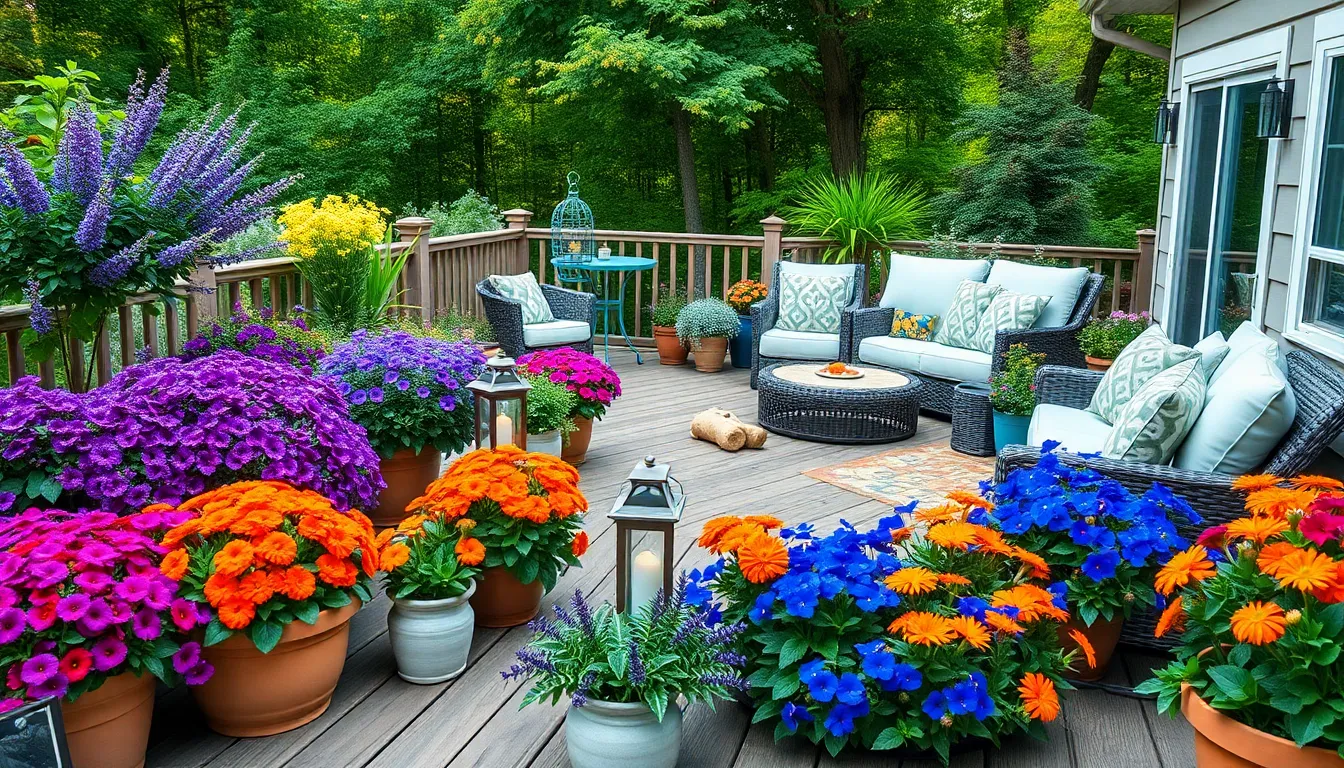
We can elevate our deck garden design by establishing exact themes that reflect our personal style and create cohesive outdoor environments. Themed sections allow us to organize plants strategically while developing focal points that enhance the overall aesthetic appeal of our deck space.
Develop Color-Coordinated Plant Schemes
Monochromatic schemes create sophisticated visual harmony by using different shades of a single color throughout our deck garden arrangements. We might choose various purple tones by combining lavender, purple petunias, and deep violet pansies to establish a calming, unified appearance. This approach works particularly well in smaller deck spaces where too many colors can feel overwhelming.
Complementary color schemes pair contrasting colors from opposite sides of the color wheel to make our garden visually striking and ever-changing. Orange marigolds paired with blue lobelia create vibrant energy, while red geraniums combined with green foliage plants offer classic appeal. These bold combinations draw attention and create natural focal points that enhance our deck’s curb appeal.
Analogous color schemes use colors that sit next to each other on the color wheel to create harmonious, flowing transitions throughout our garden sections. Yellow sunflowers, orange nasturtiums, and red zinnias blend seamlessly together, creating warm, welcoming spaces that feel naturally coordinated. This approach offers more variety than monochromatic schemes while maintaining visual cohesion.
Design Seasonal Interest Areas
Spring displays incorporate early blooming flowers and emerging foliage to celebrate renewal and fresh growth in our deck gardens. Azaleas and cherry blossoms provide spectacular flowering displays, while tulips and daffodils in containers add bright pops of color. We can position these seasonal elements in prominent areas where they’ll be most appreciated during their peak blooming periods.
Summer arrangements feature vibrant annuals and heat-loving perennials that thrive in warm weather conditions and provide continuous color. Sunflowers create dramatic height and attract beneficial pollinators, while zinnias offer long-lasting blooms in multiple colors. These summer selections ensure our deck gardens remain colorful during the peak outdoor entertaining season.
Fall transitions showcase foliage plants with changing colors and late-season bloomers that extend garden interest into cooler months. Maple and oak trees in large containers provide stunning autumn colors, while ornamental kale adds purple and white accents. We can strategically place these elements to create warm, cozy atmospheres during fall gatherings.
Winter elements include evergreen plants and cold-hardy flowers that maintain garden structure and color during dormant seasons. Pansies continue blooming in mild winter temperatures, while evergreen shrubs like boxwood provide consistent green backdrops. These winter-worthy plants ensure our deck gardens never look bare or neglected.
Incorporate Personal Style Elements
Lighting installations transform our deck gardens into enchanting evening spaces that extend usability beyond daylight hours. String lights draped overhead create magical ambiance, while lanterns positioned at varying heights add warm, intimate lighting. Solar-powered options reduce energy costs while providing consistent illumination for nighttime garden enjoyment.
Furniture selections add comfort and functionality to our themed garden sections while reflecting our personal design preferences. Comfortable seating arrangements encourage relaxation and garden appreciation, while decorative side tables provide surfaces for beverages and garden tools. We should choose weather-resistant materials that complement our chosen garden themes.
Artistic elements inject personality and creative expression into our deck garden designs through carefully selected decorative pieces. Garden sculptures serve as focal points that reflect our interests and style preferences, while wall art adds vertical interest to blank surfaces. These personal touches distinguish our gardens from generic outdoor spaces and create meaningful connections to our outdoor environments.
Establish Low-Maintenance Options for Busy Lifestyles
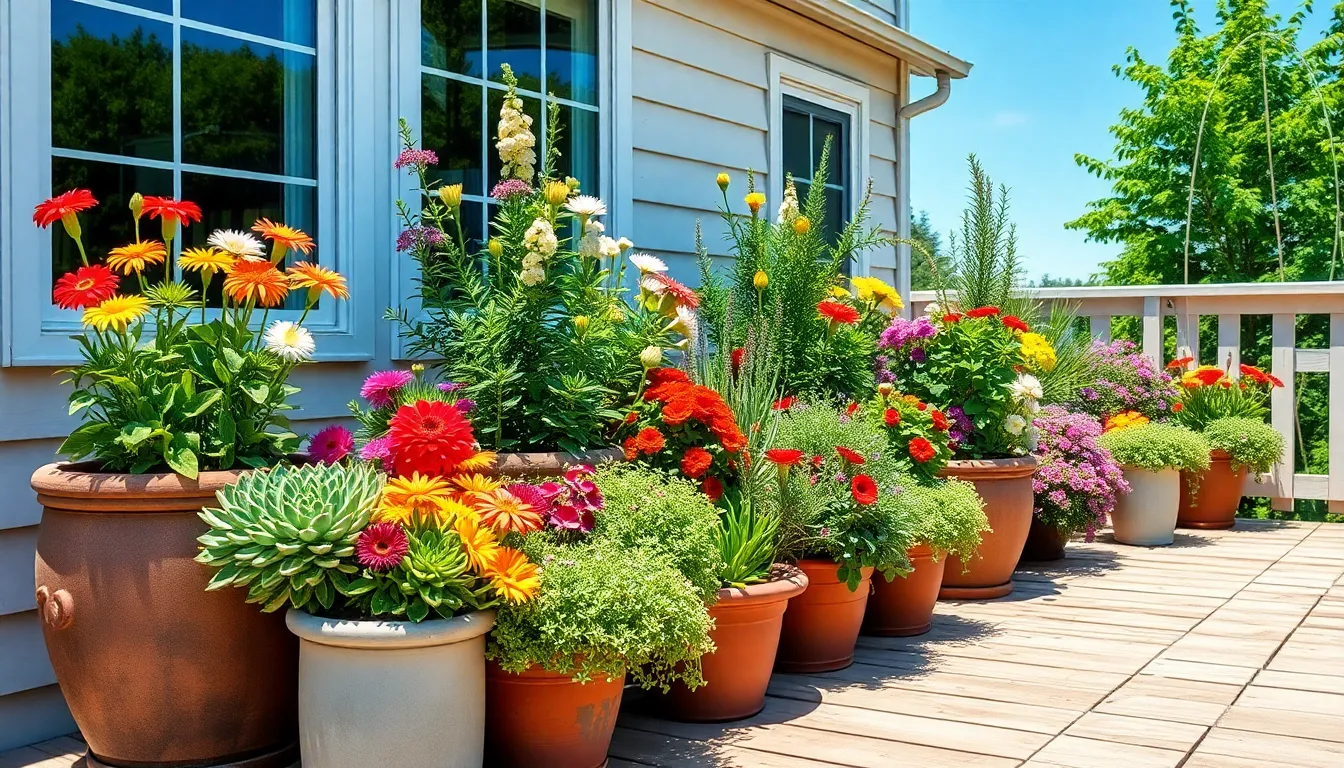
Busy schedules shouldn’t prevent us from enjoying beautiful deck gardens. Smart plant choices and efficient systems create stunning outdoor spaces that practically care for themselves.
Choose Drought-Tolerant Plant Varieties
Succulents and cacti thrive in deck containers with minimal water requirements due to their natural water-storing abilities. Varieties like sedum, echeveria, and barrel cacti create striking displays while surviving extended dry periods without compromising their visual appeal.
Drought-resistant flowers like zinnias and marigolds add vibrant colors to our deck spaces while requiring significantly less water than traditional garden blooms. These hardy annuals continue blooming throughout the season even when watering schedules become irregular.
Native plant species naturally adapt to local climate conditions and require minimal intervention once established in containers. Research your region’s indigenous varieties to discover plants that’ll flourish with whatever rainfall patterns and temperature fluctuations your area experiences.
Mediterranean herbs including rosemary, thyme, and oregano combine practical cooking benefits with exceptional drought tolerance. Their aromatic foliage releases pleasant scents during hot weather while providing fresh ingredients for our culinary adventures.
Install Automatic Watering Systems
Timed sprinkler systems can be programmed to deliver precise amounts of water at optimal times, ensuring consistent moisture levels without daily manual intervention. Modern programmable timers allow us to customize watering schedules based on seasonal needs and plant requirements.
Smart watering devices monitor soil moisture levels and automatically adjust watering frequency and duration based on real-time conditions. These intelligent systems prevent both overwatering and drought stress by responding to actual plant needs rather than preset schedules.
Drip irrigation networks deliver water directly to plant root zones through strategically placed emitters, reducing water waste while maintaining consistent soil moisture. Installing drip lines throughout our container arrangements creates efficient watering zones that operate independently of our daily routines.
Self-regulating timers connect to standard hose connections and provide reliable automation for traditional watering methods. Battery-powered models offer flexibility for deck locations without electrical access while maintaining consistent watering schedules.
Select Self-Sufficient Container Gardens
Terra-cotta pot systems arranged in tiered configurations maximize growing space while creating visually appealing displays that require minimal daily maintenance. These classic containers provide excellent drainage and allow plant roots to breathe naturally.
Self-watering containers feature built-in water reservoirs that gradually release moisture to plant roots over extended periods, reducing watering frequency to weekly or bi-weekly intervals. The reservoir systems maintain consistent soil moisture without creating waterlogged conditions.
Large-capacity planters hold greater soil volumes that retain moisture longer and provide stable growing conditions for multiple plants simultaneously. Bigger containers create mini-ecosystems that naturally regulate temperature and moisture fluctuations better than smaller pots.
Grouping complementary plants in shared containers creates beneficial growing relationships where different species support each other’s water and nutrient needs. Pairing deep-rooted plants with shallow-rooted varieties maximizes soil usage while reducing competition for resources.
Conclusion
We’ve explored countless ways to transform your deck into a thriving garden paradise that fits any lifestyle or space constraint. From vertical growing systems to mobile garden carts these strategies prove that anyone can create a productive outdoor growing space.
The key lies in choosing techniques that match your available time maintenance preferences and aesthetic goals. Whether you’re drawn to herb gardens for fresh cooking ingredients or prefer low-maintenance succulents for busy schedules there’s a perfect solution waiting.
Remember that successful deck gardening isn’t about following every suggestion—it’s about selecting the ideas that resonate with your vision and space. Start small experiment with different approaches and let your deck garden evolve naturally as you discover what works best for your unique outdoor environment.
Frequently Asked Questions
What is deck gardening and why is it beneficial?
Deck gardening involves creating gardens on decks or balconies, maximizing limited outdoor space. It offers year-round enjoyment with less effort than traditional gardening. You can grow herbs, vegetables, flowers, and ornamental plants while enhancing your outdoor space’s curb appeal. It’s perfect for urban dwellers or anyone with space limitations who still wants to enjoy fresh produce and beautiful plants.
How can I maximize space in my deck garden?
Use vertical gardening techniques by building upward instead of outward. Install modular pocket planters, wall-mounted planter boxes, and living wall systems. Choose climbing and trailing plants like sugar snap peas and cherry tomatoes. Create multi-level gardens with tiered planters and utilize deck railings for hanging gardens to transform limited space into productive growing areas.
What materials should I use for deck planter boxes?
Choose weather-resistant materials like cedar lumber, pressure-treated wood, or composite materials for durability. Build boxes 18-24 inches wide and 12-18 inches deep for optimal plant growth. Ensure proper drainage by installing landscape fabric, gravel layers, and drainage holes. Leave adequate walkway space for comfortable movement around your deck garden.
How do I create an effective watering system for my deck garden?
Install drip irrigation systems or use self-watering planters for consistent moisture. Smart irrigation controllers optimize water usage and promote healthier plants while conserving resources. For hanging gardens, choose lightweight containers and ensure proper drainage. Group plants with similar water needs together to simplify maintenance and improve efficiency.
What plants work best for deck gardens?
Select compact varieties suited for containers. Herbs like basil, thyme, and rosemary thrive near kitchen access. Choose climbing plants for vertical systems and drought-tolerant varieties like succulents for low maintenance. Mix different leaf textures and colors for visual appeal. Consider seasonal rotation to maintain year-round interest and color in your deck garden.
How can I create privacy in my deck garden?
Use tall plants and trellises to create natural privacy screens. Fast-growing options include bamboo, cypress, and arborvitae. Install sturdy support structures for climbing plants to create living privacy walls. Balance privacy with airflow using lattice panel designs. Position screening elements strategically to maintain visual interest while creating your secluded outdoor retreat.
What are the best low-maintenance deck gardening options?
Choose drought-tolerant plants like succulents, cacti, and native species that require minimal care. Install automatic watering systems with timed sprinklers and smart devices. Use self-watering containers and group complementary plants together. Utilize larger containers to create self-sufficient ecosystems. These strategies ensure beautiful gardens with minimal daily intervention, perfect for busy lifestyles.

